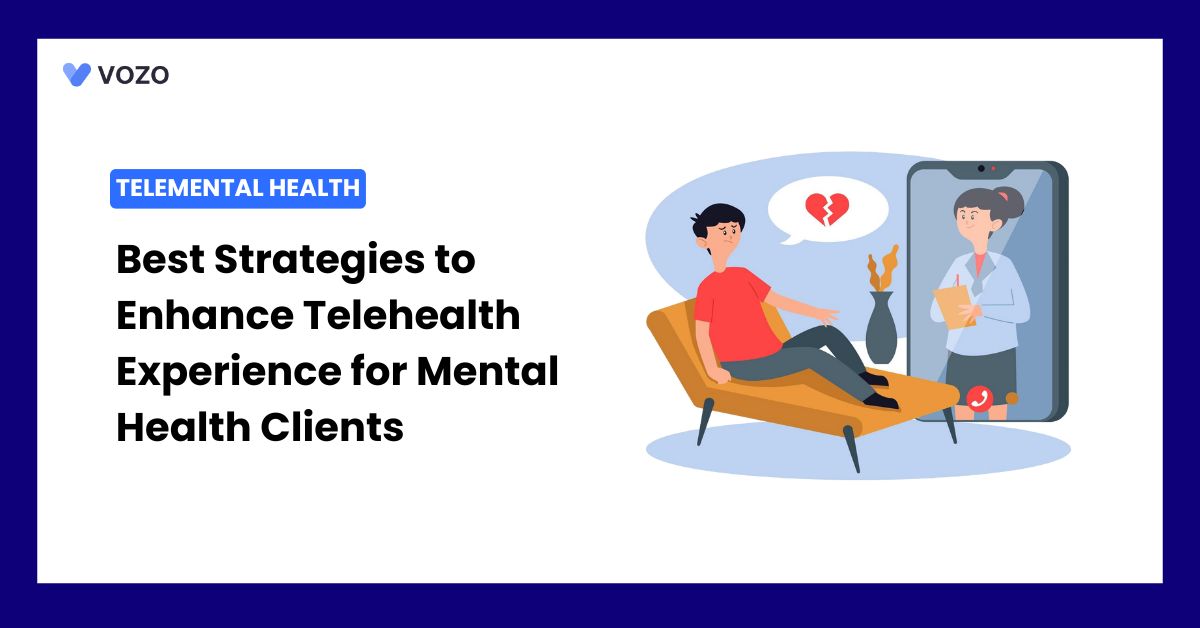Best Strategies to Enhance Telehealth Experience for Mental Health Clients
Telehealth has made a huge impact in delivering care for mental health clients. It promises greatly to improve access to mental health care like never before than the Covid-19 times.
Telemental health is a viable and successful substitute for conventional in-person care, but it necessitates that physicians embrace new approaches to establish and preserve therapeutic alliances and communication.
This might be especially problematic for practitioners who are unfamiliar with the method because they could sense the loss of the “in-session” experience more deeply.
In this blog post, we have shared a few strategies to improve the telehealth experience for mental health clients.
The Importance of Optimizing Telehealth for Mental Health Care
Telehealth has evolved and rapidly gained popularity. Most patients expect convenience in accessing healthcare, especially mental health clients.
Conducting telehealth for mental health clients means, they can experience personalized care in the comfort of their homes. Moreover, telehealth platforms offer mental health providers a greater opportunity to create a more impactful and patient-centered care experience for their clients.
Optimizing Telehealth for mental health care can help to:
- Improves Access to Remote Care
- Reduces Barriers to Vulnerable Populations
- Supports Crisis Intervention Timely
- Enhances Continuity in Treatment Plans
- Boosts Patient and Provider Engagement
- Expands Mental Health Service Reach
Related: 5 Ways Vozo Telehealth Makes Virtual Health Consultation Better
Best Strategies to Improve Telehealth Experience for Mental Health Clients
However, improving the telehealth experience is important to improve client outcomes.
1. Incorporate Connected Medical Devices for Real-Time Diagnostics
- Connected medical devices may offer the patient diagnostics immediately during virtual consultations in the form of heart and lung sounds or ECG reports.
- It increases clinical accuracy while aiming to strengthen the therapeutic relationship through more accurate assessments of patient conditions.
- Such data can easily be incorporated into EHR systems and thus maintain current and accurate records of patients.
2. Optimize Telehealth Platforms for Ease of Use
- Telehealth solutions should therefore centralize data and accommodate integration into the existing workflows to ensure seamless practice operations.
- Solutions ought to auto-populate information into EHRs.
- This reduces errors in manual entry for more time-saving accounts.
- Accessible solutions improve patient access as well as provider accessibility, hence better outcomes in treatment.
3. Provide Secure and Confidential Communication Channels
- Telehealth, privacy, and confidentiality remain the basics.
- Select a platform that encrypts communications and is standard in compliance so that the patient feels secure sharing confidential information.
- This enhances confidence with the patient as they increase participation in their mental health journey.
4. Personalize Telehealth Sessions to Meet Individual Needs
- Tailored telehealth sessions may allow better therapeutic results that are suited to the needs of a patient.
- Measurement-based care tools collect patient-reported data either before or during sessions.
- This helps to guide treatment decisions and strengthens the therapeutic alliance.
- Personalized approaches make virtual care as effective as traditional face-to-face interactions.
5. Ensure Seamless EHR Integration
- Telehealth platforms should be used in concurrent integration with EHR systems for the optimization of care delivery.
- Seamless integration helps reduce administrative burdens, makes reporting easier, and minimizes errors.
- By advancing EHR-connected telehealth solutions, providers will improve accuracy, efficiency in operation, and patient satisfaction.
Related: Telehealth for Mental Health: How Virtual Visits Can Expand Access to Therapy
Full-scale telehealth models that include connected care devices, optimizing the usability of platforms, and verifying EHR integration can all improve the quality and expansion of services available to mental health providers. These innovations provide better care accessibility and efficiency but will also help put healthcare organizations in a better competitive position for modern, patient-centered care.
Vozo Telehealth Solution for High-Quality Virtual Health Consultation
Telehealth offers significant benefits for both providers and patients. Leveraging the Vozo Telehealth and EHR Integration lets you create a more streamlined workflow for your healthcare practice.
With a vast range of features, such as scheduling appointments, audio/video/text consultation, analytics & reporting, better access to care, etc, healthcare providers and patients can:
- Reach out to patients remotely, ensuring more flexibility around appointment times.
- Saves travel time for patients and makes it easier to fit appointments into busy schedules.
- Vozo Telehealth allows anonymity and ensures patients feel more comfortable opening up from the privacy of their home space rather than in-person therapist visits.
- This eliminates the transportation cost of getting to appointments.
- It also reduces overhead costs like rent and admin staff for therapists who can conduct remote sessions, and many insurance companies do cover teletherapy as well.
- Vozo Telehealth makes it easy to maintain regular appointments, especially for patients who travel frequently or move locations.
- Therapists and patients can connect through the telehealth platform from anywhere.
The Vozo Telehealth solution enables providers to reduce burdens and focus more on better patient outcomes remotely.
Reach out to Vozo and utilize cutting-edge telehealth solutions for better convenient quality healthcare.
About the author

With more than 4 years of experience in the dynamic healthcare technology landscape, Sid specializes in crafting compelling content on topics including EHR/EMR, patient portals, healthcare automation, remote patient monitoring, and health information exchange. His expertise lies in translating cutting-edge innovations and intricate topics into engaging narratives that resonate with diverse audiences.













